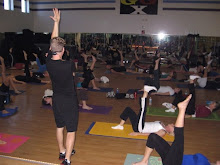Yet another benefit of practicing yoga!
Yoga Aids Computer Users
by Shirley Archer, JD, MA
Yoga instructors may want to incorporate traditional vision exercises into classes in order to benefit participants who work daily at computer screens. Computer workers who practiced yoga for 60 days improved visual comfort and reduced “dry eye,” according to a study published in Head & Face Medicine (2006; 2 [46]; www.head-face-med.com/content/2/1/46).
Since yoga practices are known to reduce eye strain among people with progressive nearsightedness, researchers at the Swami Vivekananda Yoga Research Foundation in Bangalore, India, conducted a study with employees of a local software development company to determine whether yogic practices could assist professional computer users.
Two hundred and ninety-one male and female employees participated in the trial. An office assistant randomly assigned individuals to either the yoga group or the wait list control group. Members of the yoga group practiced yoga for 1 hour per day, 5 days per week. Practice consisted of 15 minutes of asanas, 10 minutes of pranayama, 10 minutes of joint exercises, 10 minutes of trataka or visual cleansing exercises and 15 minutes of guided relaxation. The trataka included two sets of eye exercises: (1) shifting the eyes in eight directions, while moving an extended thumb to direct the gaze; and (2) looking at a flame at eye level without blinking, while focusing and defocusing their eyes. Control group participants spent an equivalent amount of time engaging in their usual recreational activities.
After 60 days, members of the yoga group reported reduced visual discomfort. Study authors suggested that these improvements were the result of an improved ability to focus while remaining relaxed, which may have increased the blink rate that provides more eye lubrication. Previous studies have shown that individuals blink more when relaxed. Researchers noted that a limitation of this study was that improvements in comfort were based on self-reporting, rather than on well-recognized objective indicators of visual discomfort. More study was recommended, since yoga could provide a safe, beneficial, nonpharmacological treatment for a prevalent problem among office workers.
Monday, March 26, 2007
Subscribe to:
Posts (Atom)
